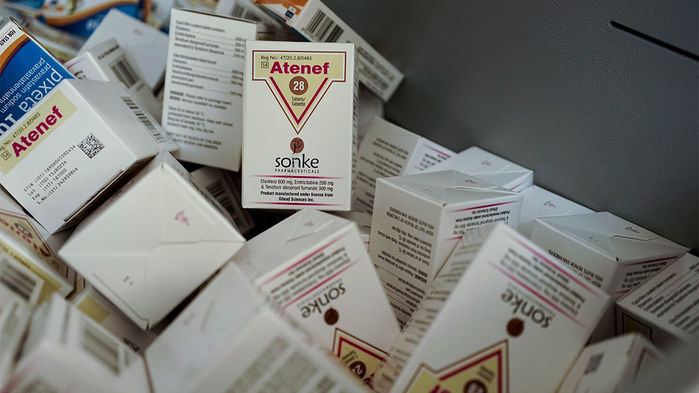A new update on the global HIV/AIDS epidemic offers “scorecards” for countries that starkly highlight successes in green and failures in red (for an example, see chart at bottom of story).
Collectively, the world receives high marks for its HIV/AIDS efforts from the Joint United Nations Programme on HIV/AIDS (UNAIDS) in Geneva, Switzerland. It notes in Ending AIDSthat 19.5 million of the estimated 36.7 million people living with the virus now receive lifesaving antiretroviral (ARV) drugs. This is the first time in history that more than half the infected people are being treated.
But several countries are falling far short of the UNAIDS prescription of what it takes to bring an epidemic to an end, which essentially requires slowing the rate of virus transmission to the point that new infections peter out.
The report dramatically documents the power of ARVs, which both stave off disease and make people less likely to infect others. AIDS deaths have almost been cut in half since 2005, when only 564,000 HIV-infected people received ARVs. In the past 6 years, the hard hit eastern and southern Africa region has seen new infections plummet by one-third. Recognizing that proper treatment also makes people less likely to transmit HIV, many countries have adopted the World Health Organization’s 2015 recommendation to treat everyone who tests positive, abandoning the practice of reserving ARVs for those with evidence of immune system damage. “Families, communities, cities and countries have witnessed a transformation,” writes UNAIDS director Michel Sidibé in the foreward to the 196-page report.
UNAIDS announced in 2014 that the world could bring the AIDS epidemic to an end if countries could achieve the following goals by 2030: Ninety percent of infected people know their HIV status, 90% of that group starts on ARVs, and 90% of those on treatment stick with it and reduce the levels of virus in their blood to below the level of detection on standard tests. This 90-90-90 strategy is the benchmark UNAIDS uses in its new report to score the performance of countries. “When I launched the 90–90–90 targets three years ago, many people thought they were impossible to reach,” Sidibé writes. “Today, the story is very different.”
As the report emphasizes, “substantial progress” has been made toward 90-90-90. Based on 168 countries reporting data, the overall bottom line for the world was 70-77-82 in 2016. Seven countries have hit the 90-90-90 target, and 11 others are close. “Remarkable progress,” in the report’s words. But it does not sugarcoat the situation. “Within this clear-cut picture of progress lurk troubling barriers to success.”
For countries to achieve the UNAIDS goal, 73% of their HIV-infected populations must have fully suppressed the virus. (This is calculated by multiplying 90 x 90 x 90.) HIV epidemics only continue if each infected person spreads the virus to at least one other person. At 73% suppression, there theoretically are enough breaks in the transmission chain to end epidemic spread.
Globally speaking, however, only 44% of HIV-infected people are fully suppressed, leaving room for epidemics to continue.
Seven countries have managed to hit the 73% suppression milestone. They are Botswana, Cambodia, Denmark, Iceland, Singapore, Sweden, and the United Kingdom.
In contrast, countries with the worst suppression levels include Madagascar (3%), Pakistan (4%), Gabon (7%), Iran (8%), Egypt (12%), Lithuania (17%), Dominica (17%), Bahamas (18%), and Ecuador (19%).
Many factors
There are many other factors fueling the epidemic. Many people still start treatment only after they have suffered extensive immune system damage. Few countries take advantage of the scientifically proven prevention strategy of offering ARVs to people at high risk, in what’s known as pre-exposure prophylaxis. Some countries with substantial spread from drug users who share their injecting equipment reject “harm reduction” strategies like providing clean needles and syringes and offering methadone substitution.
In Eastern Europe and Central Asia, only 22% of HIV-infected people are virally suppressed, which helps explain why new infections jumped by an “alarming” 60% in those regions between 2010 and 2016. AIDS deaths there over the past decade went up 38%. An estimated 42% of the new infections in 2015 were in people who inject drugs, and harm reduction has made little headway in most countries. Russia has the region’s worst report card, accounting for 81% of the new infections. In a recent survey, only 13% of HIV-infected men in Russia who have sex with men there knew their status. (Russia did not publish or provide UNAIDS with enough data for the report to fill in its scorecard.)
The United States, surprisingly, also did not provide enough finalized data for UNAIDS to fill out its scorecard. The report does note that new infections in the country declined by 18% between 2008 and 2014, which it says is “the first meaningful decline in new infections in the country in two decades.” But there was a 20% jump in new HIV infections in Latino men who have sex with men during that period. And the latest available report from the U.S. Centers for Disease Control and Prevention—which has 2011 data—suggests the country had a long way to go before it hit the UNAIDS target: Only 30% of the estimated 1.2 million HIV-infected people were virally suppressed.

